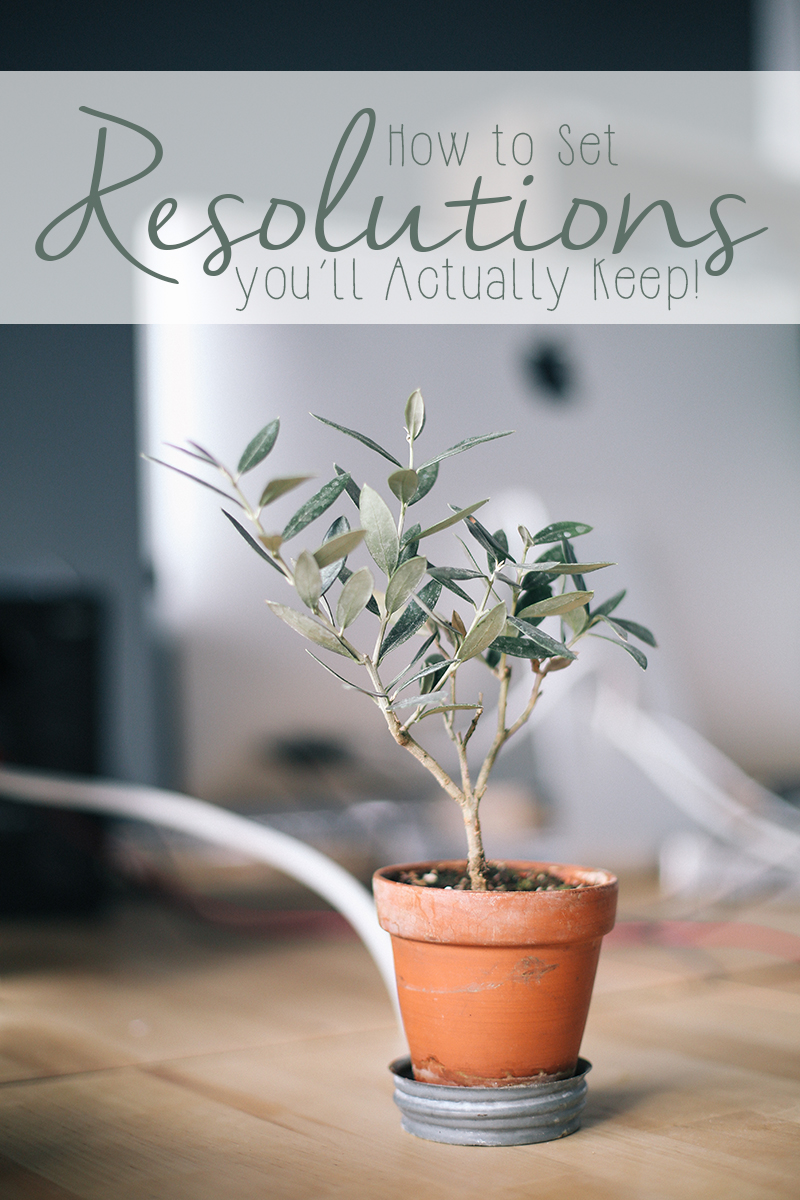This year, I’m quitting resolutions altogether. I know that’s an odd statement to make in the very beginning of a post all about making resolutions you’ll keep, but stick with me here… the best way to set resolutions you’ll actually keep is to STOP MAKING RESOLUTIONS. That doesn’t mean not to resolve to do anything… but it means changing your mindset and your tactics so you can experience resolution success.
The first step I took to setting a resolution was to identify the parts of my life that needed work. For me in 2016, that was my spiritual life, my personal life, my business life, and my financial life. You can start with just one part of your life and set it as a focus for a quarter, or a month, or whatever you’d like, or you can try to focus on a few at a time, but the best thing you can do is not bite off more than you can chew. Setting down with just one small goal might be a good idea in the beginning– if you start too large, it’ll set you up for defeat, not success. I isolated four areas of my life, and set timelines for each that I wanted to work on.
Once you’ve isolated the areas of your life you really want to work on, it’s time to start setting your tangible, measurable goals. For me, this meant identifying 3 things that would help me with each of my goals.
For example, under my personal life, I decided to focus on the following:
1. Say “yes” to more non-work things… for me, this is essential because I so many of my hobbies and things I enjoy overlap with work. Saying “yes” to non-work things may mean getting down on the floor and playing with Zach, regardless of upcoming deadlines. It may mean spending the evening with a cup of coffee and a coloring book. It just means that sometimes, I set aside time for things that won’t show up on this digital space.
2. Planning a Zach and Mommy day each month… we spend quality time together, and that’s a lot of why I’ve chosen a job that allows me to work from home. That said, we don’t always intentionally set aside time for one-on-one time to just do something fun. For us, that means each month, we’ll schedule a day with a specific plan for doing something great.
3. Declutter and make a space that works for us… this means that I want to take time to go through the unnecessary items we have (post-Christmas, it means we have a lot that needs to be tossed or sold to make room for the new– old toys he’s outgrown, old work stuff I’ve used to the death, and just miscellaneous that needs re-organized).
For each area, I isolated 3 items that would work for improving that aspect of my life, and then under each of those, I set a realistic plan.
When it comes to the business side of my life, I realized I had a lot of classes and conferences that I had paid for, but hadn’t fully utilized. These are things that would help me improve my business life, and since I’ve already paid for them, I need to use them.
To take this from “goal” to “tangible goal,” I scheduled time each month for a “school day.” This school day would be spent sitting down, blocking out distractions, and taking a course or going through a conference session, and taking the first steps to apply it to my life.
Remember, a tangible goal has a set timeline, a way to know when you’ve completed it, and is measurable. For example, saying “I want to lose weight” is a good ambition, but it certainly isn’t a goal. Instead, saying “I want to lose 15 pounds by my vacation in July” is a goal because it’s measurable, it has a set timeline, and you’ll know when you’ve finished it. But beyond saying “I want to lose 15 pounds by my vacation in July,” it helps to start by identifying a few ways you can complete that goal. Examples would be “I will lose 15 pounds by my vacation in July by using a calorie tracking app to keep track of what I’m eating, by increasing my water intake to one gallon a day, and by walking one mile after work each day.” After a month, you can take time to re-evaluate– if you haven’t lost weight, perhaps you want to add other goals.
For me financially, I want to make an effort to increase my long-term savings and my emergency fund. I’ll be doing this by using a money tracking app to see how I’m spending my money, setting a goal amount I’d like to have in my long term savings and my emergency fund by the end of 2016, and by making an appointment with myself to go over my budget each month and check for any areas where I can improve. By setting a monetary goal, and identifying ways I can check in with myself throughout the year, I’ll be more likely to actually achieve the goal than if I had said “I want to save more money in 2016.”
To recap, when it comes to setting a resolution you’ll keep, you need to:
1. Identify what you’d like to work on.
2. Consider ways to reach that progress.
3. Set measurable goals with a definite end.
4. Make time for checkpoints along the journey to ensure you’re on track to reach your goal.
If you’re not on track, identify what you need to do to get on track and adjust your goal accordingly. To go back to our weight loss plan, if in May, you realize you haven’t lost any weight, 15 pounds may no longer be attainable, but you may be able to re-evaluate and decide you’d like to lose 5 pounds before vacation, or decide you want to lose 15 pounds by the end of summer in August. Sometimes, our goals don’t go as planned– in my money goal, an unexpected emergency could derail my savings. But rather than letting that end my journey, I can use it as a launching point to continue my effort.
This year, don’t get discouraged… take time to plan out a goal and work hard to achieve it, and you’ll have so much more success than setting a general, vague resolution.
What’s your biggest goal this year? Let me know in the comments below! For great resolution ideas, check out this post on 6 things you can learn for free this year, or check out these fun resolutions for kids.





